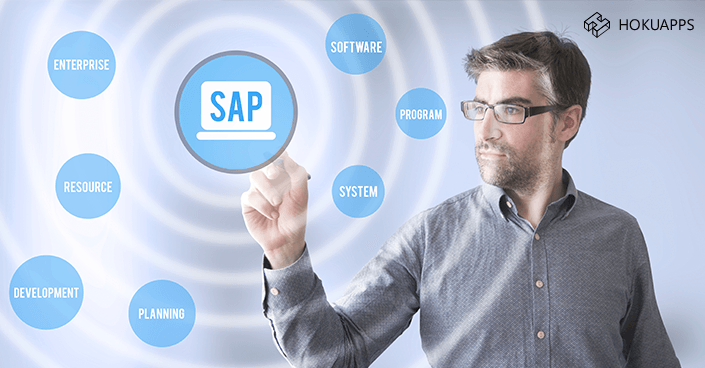- Products
- Solutions
- Services
- Resources
- Customer Success
- Company
- Sign In
- Contact Us

Companies each day are inundated with SAP application integration challenges. Businesses that do not integrate their SAP systems run the risk of failing to optimize critical business functions, resulting in reduced business agility and business process inefficiencies. Businesses, therefore, are continually looking for ways to integrate multiple stand-alone applications into a single application to reduce integration costs while concurrently focusing on ways to accelerate profitable growth. Also, the SAP landscape has been evolving over the past several years and companies looking to integrate their SAP systems have witnessed the burgeoning of SAP integration applications that have transformed the way businesses are controlling all aspects of their operations.
This blog post, thus, highlights some of the common trials faced when integrating SAP and provides an overview of SAP interface and integration technologies, and discusses the many approaches for solving SAP integration challenges.
Several SAP integration and interface technologies exist simultaneously. They facilitate integration between SAP and non-SAP applications.
1.Intermediate documents or IDOCs are SAP objects that facilitate information exchange between SAP and non-SAP applications. This standard data format serves as a medium for transferring master data to and from SAP, and is typically used for asynchronous transactions. With IDOCs, you can retrieve a multitude of information such as information pertaining to suppliers, cost centers, and logistics such as bills of materials. The IDOC once triggered in SAP transmits business transaction data from one system to another.
2.Another core SAP technology that allows you to send data to the ERP system is the Business Application Programming Interface (BAPI). This standardized programming interface is utilized by both SAP and non-SAP applications. While IDOCs are typically used for the asynchronous transaction, BAPI, on the other hand, is used in synchronous scenarios where two-way communication is required. One of the many advantages of BAPI is that it can function independently of IDOCs and allow businesses to achieve seamless SAP integration with non-SAP systems and external application. For example, if an organization intends to manage or regulate its cost centers from an external application, they can do by obtaining a list of profit or cost centers or create new ones using a BAPI object. Numerous BAPIs are available for SAP that enables businesses to achieve seamless SAP integration.
3.Lastly, the SAP Java Connector (JCo) is an integrated component that can be implemented with desktop and web server applications. The JCo SAP connector facilitates the development of SAP-compatible components and applications in Java and simultaneously allows Java applications to communicate to any SAP systems. For the above reason, JCo is a universal middleware component in SAP ecosystems.
This section illustrates the key approaches to integrating with SAP and also highlights the many positives and negatives of each approach.
The key SAP interfaces of IDOCs, BAPIs, and JCo can interact and integrate with software applications. Developers are always on the lookout for ways to expedite integration with SAP systems and the point-to-point integration architecture is one of the approaches that offer rapid point-to-point integration between two specific applications. This approach, however, is a more complex, expensive, and cumbersome way to SAP Integration than the Service Oriented Architecture (SOA). Moreover, this integration architecture can only support tight coupling with SAP, thereby making it a less flexible approach since the SAP landscape is prone to changes.
As business processes evolve and new integration scenarios are required, the point-to-point integration architecture fails to offer additional touch points and tight dependencies. This significantly reduces business agility and is generally not the ideal long-term solution.
SOA is another approach to integrating with SAP. SOA stacks comprise multiple products, including — but not restricted to — application servers, enterprise service bus, orchestration engines, and management and development tools.
One of the many benefits of implementing the SOA components is that it creates a robust integration architecture that supports most use cases. Applications are loosely coupled in the SOA landscape and, in case changes are needed, this enterprise solution effectively addresses them. This integration architecture is also responsible for reducing application maintenance costs and is considered a more reliable platform than the point-to-point and hub-and-spoke approaches. Once the SOA integration framework is implemented, the cost of procuring additional applications for supporting new business processes and the complexity that comes with it is considerably reduced. The SOA approach, thus, allows organizations to create, consolidate, and deploy services, thereby catering to varying business needs.
On the downside, SOA stacks involve a multitude of products which must all be deployed and configured. Also, implementation of an SOA can take multiple years and can involve higher upfront costs. This, in turn, can negatively impact the application development process. On the other hand, all developers need to be trained on proprietary software and recruiting new developers can pose a serious challenge to the requirement for specialist knowledge skyrockets. As a result, many organizations are still struggling to solve the SAP integration challenges.
The Enterprise Service Bus (ESB) architecture is at the center of application workflow and is a more advanced approach that supports SAP integration. ESBs are also regarded as a fundamental component of an SOA stack. ESBs very effectively implement, maintain, and manage traditional SOAs. Stand-alone ESBs provide their own management tools or integrate with the management tools used by an organization. An ESB’s primary function is to transmit messages between applications and components.
In other words, an ESB works as a unifier where it unites the numerous ways in which components can receive or send information to other application elements. Moreover, they also utilize development tool and technologies that users are already familiar with. Stand-alone ESBs are, thus, regarded as the optimal solution for SAP integration. Like other approaches to SAP integration, stand-alone ESBs reduce upfront costs and eliminates the risks associated with other SAP integration scenarios. Thus, the approaches outlined above allow organizations to meet their business objectives and accomplish business goals within a short span of time.
The benefits of the HokuApps SAP integration platform are manifold. The SAP integration platform offers businesses integration services that are secure, reliable, and delivered and managed by SAP. HokuApps SAP supports integration between processes and data between on-premise, Cloud applications, and other external third-party applications.
HokuApps SAP integration with custom SAP connector is also easy for developers to learn and assimilate. This, in turn, can eliminate all challenges pertaining to training, staffing, and other development costs and enhance the speed at which organizations can develop and deliver applications and that will eventually streamline and automate business processes and also provide an interconnected landscape that will help organizations gain a competitive edge.
When compared to other alternatives, HokuApps comparatively expedites the SAP-application integration process, thereby creating new business opportunities and simultaneously laying the foundation for future projects. With HokuApps, businesses can thus expect a higher long-term return on investment.